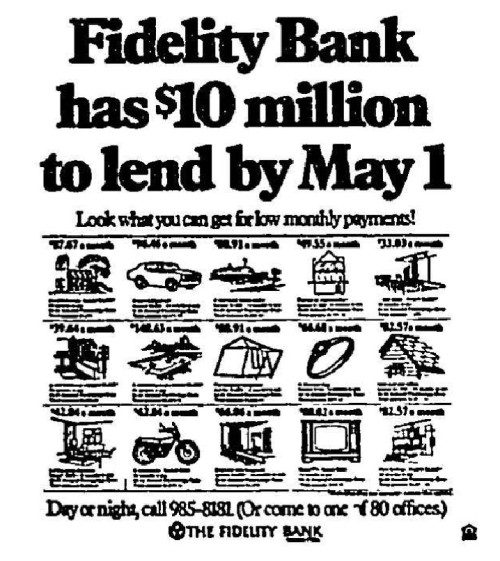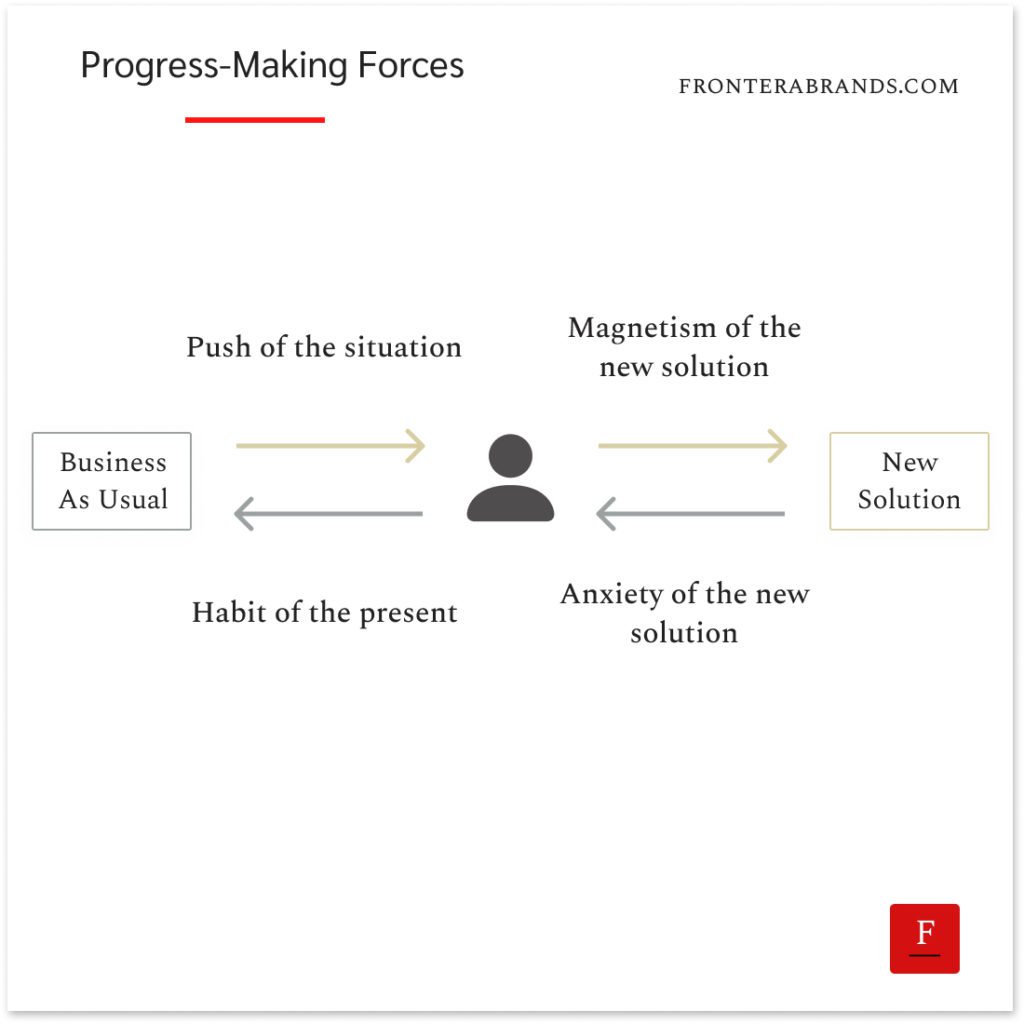In the early 1970s, The Fidelity Bank had a lot of money to lend.
But nobody was asking for a loan.
So they hired Ogilvy & Mather agency to make a new campaign.
Now, imagine you are an Ogilvy copywriter.
You have to write an ad to sell more loans.
But there is a problem.
All banks sell the same product.
The interests and conditions are more or less the same for all.
So how do you sell this thing?
They did something smart.
As the product was essentially the same, they decided to focus on customers.
Why do customers get loans?
To buy new stuff or handle an unexpected payment.
No useful insights here.
But why don’t they get loans even though the bank is ready to give them money?
Well, most people think they might get rejected — even when they are suitable for a loan.
People like buying stuff.
But they don’t like rejection.
So the anxiety of a potential rejection keeps them away from applying for a loan.
Ogilvy’s copywriters decided to focus the campaign on this anxiety.
If their advertising could reduce it, they could sell more.
After a few weeks of work, they came up with one of the simplest headlines in advertising history:

Here’s the funny thing.
Other banks also had money available for lending.
That’s what banks do — and everybody knows it.
But Ogilvy’s genius ad showed The Fidelity Bank was ready to lend money.
There was nothing to be anxious about.
Sure, the other banks also wanted to lend money to customers.
But they were talking about interest rates and conditions.
The Fidelity Bank said:
“Just come and ask for the money, we’ll give it to you.”
You know the result?
They lent all their capacity.
Why customer inertia can be your biggest competitor
The Fidelity Bank’s campaign is an interesting story.
But listen to this.
After analyzing 2.5 recorded sales conversations, Matthew Dixon and Ted McKenna found out that 40% to 60% of deals —including transactional and complex sales— end up with no decision.
So people look for a solution, they compare alternatives, and talk to them, yet they still don’t buy any.
Why?
Because they get paralyzed.
Sometimes because of anxiety about the new solution.
Sometimes because of the existing habits.
Bob Moesta formulized this in his book Demand-Side Sales as progress-making forces.
He says there are four forces that lead customers to make a decision on a purchase.
I’ll use a fat loss example to explain:
- Push of the situation (+): Frustrations with the status quo (e.g. not liking yourself in the mirror or not fitting into your clothes)
- Magnetism of the new solution (+): The benefits to be gained from the change (e.g. looking good, being healthy)
- Habit of the present (-): The existing behaviors that created a comfort zone (e.g. consuming a lot of alcohol and sugar on a regular basis, free time in the evenings instead of going to the gym)
- Anxiety of the new solution (-): The anxiety comes from the cost/effort to change or a possible failure (e.g. the challenge to stick with a strict diet or “what if this training program doesn’t work”)

So what does that mean?
It means when the positive forces are not strong enough to beat the negative ones, inertia wins.
Customers continue business as usual.
And they don’t make a purchase.
So your brand doesn’t only compete with other brands — but also with customer inertia.
And to break inertia, you need to increase the positive forces and decrease the negative ones.
How?
Four Ways To Beat Customer Inertia:
1. See the world through customers’ eyes
Progress-making forces are based on one core idea.
Selling is about the customer’s life first.
What are customers trying to accomplish?
What are the moments that lead them to look for a solution (remember buying triggers)?
And why do (or don’t) they buy?
Once you see everything from their perspective, you can help them make that progress.
You can talk to their real needs with your marketing.
You can relieve their anxiety about the change.
And selling becomes easy.
So forget about your service, product, or offer for a second.
Find the real progress customers are trying to make beyond functional ones.
Sometimes people buy stuff to show their identity.
Sometimes they purchase a tool to stop listening to their direct reports complaining every week.
And sometimes they contract a service to have peace of mind.
There is always an emotional or social reason.
Remember the jobs-to-be-done framework.
As Peter Drucker said:
“People rarely buy what the company thinks it’s selling.”
2. Consider the status quo while positioning
We talk about positioning against competitors — like BMW vs Mercedes.
But if many customer decisions end up with no purchase, that means you also have to position against customers’ status quo.
And this can be an alternative that’s not your direct competitor.
April Dunford gives the example of how even “We have an intern to do it” can be a competitor to software solutions.
You know what that means?
Showing your brand’s difference against competitors is not enough.
You should also show the value against the customer’s status quo.
What’s the existing alternative they’ll stick to instead of yours?
Why should they choose you instead of continuing as-is?
The better you answer these with your messaging, the more you strengthen the positive forces.
3. Eliminate the confusion
Customers want to make informed decisions in today’s world.
Information is accessible — so they research.
There are alternatives for everything — so they compare.
But ironically, this makes the decision harder.
They get lost in the ocean of information.
They get confused.
And when they are confused about their options, the decision anxiety kicks in.
So inertia wins.
What does that mean for your marketing?
It’s simple.
You should leave no room for confusion.
The problem you solve.
Who you solve it for.
And how you are different than others.
Everything should be clear.
Everything should be communicated consistently at every touchpoint.
We talked about why simple brands win and why value tradeoffs increase believability.
When you clearly show what you stand for, you leave no room for confusion.
It becomes easier for customers to make a decision.
4. Think about non-customers
Ogilvy’s copywriters did this for Fidelity Bank.
They thought:
“Why don’t more people apply for a loan?”
And the answer they found was the anxiety of rejection.
They fixed the anxiety.
They sold all of their lending capacity.
So sometimes real insights don’t come from customers.
But they come from non-buyers.
Why do some people don’t choose any of the alternatives?
What is keeping them from making that progress?
These questions can show you the negative forces that keep inertia.
So you can address them and attract new customers who have never bought any of the alternatives before.
Remember how Yellow Tail dominated the competitive US wine market as a new player.
It’s funny how customer anxiety can be one of the main obstacles to your brand’s growth.
–
Enjoyed this article?
Then you’ll love the How Brands Win Newsletter.
Get the “7 Positioning Sins That Cost B2B Brands Millions” guide when you join. It’s free.
